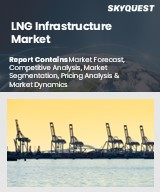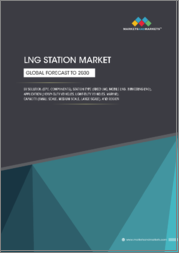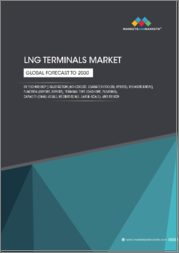
|
시장보고서
상품코드
1771216
계획 LNG 시장 - 세계 산업 규모, 점유율, 동향, 기회, 예측, 기술별(액화, 재기화), 용도별(주택, 상업, 산업), 지역별, 경쟁 시장별(2020-2030년)Planned LNG Market - Global Industry Size, Share, Trends, Opportunity, and Forecast, Segmented By Technology (Liquefaction, Regasification), By Application (Residential, Commercial, Industrial), By Region, By Competition, 2020-2030F |
||||||
계획 LNG 세계 시장 규모는 2024년에 541억 달러로 평가되었고, 예측 기간 중 연평균 복합 성장률(CAGR)은 6.4%를 나타내고, 2030년에는 792억 달러에 이를 것으로 예측됩니다.
세계 에너지 수요 증가와 청정 연료로의 전략적 전환으로 인해 LNG 시장은 빠르게 성장하고 있습니다. 액화천연가스(LNG)는 석탄이나 석유에 비해 탄소 배출량이 적은 것으로 알려져 있으며, 전 세계 탈탄소화 목표에서 중요한 전환 연료로 자리매김하고 있습니다. 중국, 인도, 동남아시아 국가들을 포함한 아시아태평양 국가들은 급속한 도시화와 산업화로 LNG 수요를 주도하고 있습니다. 동시에 유럽과 일본과 같은 성숙한 시장에서는 국내 가스 생산량 감소로 인해 LNG 수입 기지에 대한 대규모 투자가 이루어지고 있습니다. 파리협정과 같은 기후 변화에 대한 약속과 함께 에너지 안보의 추진은 전 세계 LNG 인프라를 재구성하고 있습니다.
| 시장 개요 | |
|---|---|
| 예측 기간 | 2026-2030년 |
| 시장 규모 : 2024년 | 541억 달러 |
| 시장 규모 : 2030년 | 792억 달러 |
| 2025-2030년 CAGR | 6.4% |
| 급성장 부문 | 액화 |
| 최대 시장 | 북미 |
시장 성장 촉진요인
세계 에너지 수요 증가와 청정 에너지로의 전환
주요 시장 이슈
높은 설비 투자 및 긴 프로젝트 개발 기간
주요 시장 동향
부유식 LNG(FLNG) 및 소규모 LNG 솔루션의 등장
목차
제1장 개요
제2장 조사 방법
제3장 주요 요약
제4장 고객의 소리
제5장 세계의 계획 LNG 시장 전망
- 시장 규모와 예측
- 금액별
- 시장 점유율과 예측
- 기술별(액화, 재기화)
- 용도별(주택, 상업, 산업)
- 지역별(북미, 유럽, 남미, 중동 및 아프리카, 아시아태평양)
- 기업별(2024년)
- 시장 맵
제6장 북미의 계획 LNG 시장 전망
- 시장 규모와 예측
- 시장 점유율과 예측
- 북미 : 국가별 분석
- 미국
- 캐나다
- 멕시코
제7장 유럽의 계획 LNG 시장 전망
- 시장 규모와 예측
- 시장 점유율과 예측
- 유럽 : 국가별 분석
- 독일
- 프랑스
- 영국
- 이탈리아
- 스페인
제8장 아시아태평양의 계획 LNG 시장 전망
- 시장 규모와 예측
- 시장 점유율과 예측
- 아시아태평양 : 국가별 분석
- 중국
- 인도
- 일본
- 한국
- 호주
제9장 중동 및 아프리카의 계획 LNG 시장 전망
- 시장 규모와 예측
- 시장 점유율과 예측
- 중동 및 아프리카 : 국가별 분석
- 사우디아라비아
- 아랍에미리트(UAE)
- 남아프리카공화국
제10장 남미의 계획 LNG 시장 전망
- 시장 규모와 예측
- 시장 점유율과 예측
- 남미 : 국가별 분석
- 브라질
- 콜롬비아
- 아르헨티나
제11장 시장 역학
- 성장 촉진요인
- 과제
제12장 시장 동향과 발전
- 인수합병(M&A)
- 제품 출시
- 최근 동향
제13장 기업 개요
- ExxonMobil
- Royal Dutch Shell
- Qatar Petroleum
- Chevron Corporation
- TotalEnergies
- Cheniere Energy
- PetroChina
- Eni S.p.A.
제14장 전략적 제안
제15장 회사 소개 및 면책조항
LSH 25.07.22The Global Planned LNG Market was valued at USD 54.1 billion in 2024 and is projected to reach USD 79.2 billion by 2030, registering a CAGR of 6.4% during the forecast period. The market is expanding rapidly due to increasing global energy demand and a strategic shift toward cleaner fuels. Liquefied Natural Gas (LNG), known for its lower carbon emissions compared to coal and oil, is being positioned as a critical transitional fuel amid global decarbonization goals. Countries across the Asia-Pacific region, including China, India, and Southeast Asian economies, are leading LNG demand due to rapid urbanization and industrialization. Simultaneously, declining domestic gas production in mature markets like Europe and Japan is driving substantial investments in LNG import terminals. The push for energy security, coupled with climate commitments under frameworks such as the Paris Agreement, is reshaping the global LNG infrastructure landscape.
| Market Overview | |
|---|---|
| Forecast Period | 2026-2030 |
| Market Size 2024 | USD 54.1 Billion |
| Market Size 2030 | USD 79.2 Billion |
| CAGR 2025-2030 | 6.4% |
| Fastest Growing Segment | Liquefaction |
| Largest Market | North America |
Key Market Drivers
Rising Global Energy Demand and Clean Energy Transition
The increasing global demand for energy-particularly in fast-growing economies-is a key driver of planned LNG infrastructure development. Emerging countries such as China and India are accelerating their shift from coal and oil to cleaner energy sources, with LNG emerging as a preferred option due to its reduced greenhouse gas emissions. As nations aim to meet climate targets and diversify their energy portfolios, LNG is being integrated into national energy strategies for both base load and peak power supply. Government-backed initiatives promoting cleaner fuel adoption are reinforcing this trend, making LNG a central component of the global clean energy transition.
Key Market Challenges
High Capital Investment and Long Project Development Timelines
A primary challenge in the planned LNG market lies in the high upfront costs and extended timelines required for project development. LNG terminals-whether for liquefaction or regasification-demand significant capital expenditure and involve intricate engineering, environmental permitting, and construction efforts. Projects often span 5 to 7 years before becoming operational, making them vulnerable to market risks such as energy price volatility, regulatory shifts, and geopolitical uncertainties. These factors can deter investor confidence and delay project execution, especially in regions with less stable economic environments or evolving energy policies.
Key Market Trends
Emergence of Floating LNG (FLNG) and Small-Scale LNG Solutions
A transformative trend in the planned LNG market is the increasing deployment of Floating LNG (FLNG) units and Small-Scale LNG (SSLNG) systems. FLNG technology enables offshore extraction, liquefaction, and export of natural gas, eliminating the need for costly onshore infrastructure. This approach offers faster deployment, reduced permitting complexity, and flexibility for remote or deepwater fields. Countries like Mozambique, Nigeria, and Indonesia are adopting FLNG solutions as part of their energy expansion plans. Similarly, SSLNG is gaining momentum for decentralized applications, serving remote communities, islands, and industrial users that are not connected to pipeline networks. These innovations are expanding market access and enhancing the flexibility of LNG supply chains.
Key Market Players
- ExxonMobil
- Royal Dutch Shell
- Qatar Petroleum
- Chevron Corporation
- TotalEnergies
- Cheniere Energy
- PetroChina
- Eni S.p.A.
Report Scope:
In this report, the Global Planned LNG Market has been segmented into the following categories, in addition to the industry trends which have also been detailed below:
Planned LNG Market, By Technology:
- Liquefaction
- Regasification
Planned LNG Market, By Application:
- Residential
- Commercial
- Industrial
Planned LNG Market, By Region:
- North America
- United States
- Canada
- Mexico
- Europe
- Germany
- France
- United Kingdom
- Italy
- Spain
- Asia Pacific
- China
- India
- Japan
- South Korea
- Australia
- South America
- Brazil
- Colombia
- Argentina
- Middle East & Africa
- Saudi Arabia
- UAE
- South Africa
Competitive Landscape
Company Profiles: Detailed analysis of the major companies present in the Global Planned LNG Market.
Available Customizations
Global Planned LNG Market report with the given market data, Tech Sci Research offers customizations according to a company's specific needs. The following customization options are available for the report:
Company Information
- Detailed analysis and profiling of additional market players (up to five).
Table of Contents
1. Product Overview
- 1.1. Market Definition
- 1.2. Scope of the Market
- 1.2.1. Markets Covered
- 1.2.2. Years Considered for Study
- 1.2.3. Key Market Segmentations
2. Research Methodology
- 2.1. Objective of the Study
- 2.2. Baseline Methodology
- 2.3. Key Industry Partners
- 2.4. Major Association and Secondary Sources
- 2.5. Forecasting Methodology
- 2.6. Data Triangulation & Validation
- 2.7. Assumptions and Limitations
3. Executive Summary
- 3.1. Overview of the Market
- 3.2. Overview of Key Market Segmentations
- 3.3. Overview of Key Market Players
- 3.4. Overview of Key Regions/Countries
- 3.5. Overview of Market Drivers, Challenges, and Trends
4. Voice of Customer
5. Global Planned LNG Market Outlook
- 5.1. Market Size & Forecast
- 5.1.1. By Value
- 5.2. Market Share & Forecast
- 5.2.1. By Technology (Liquefaction, Regasification)
- 5.2.2. By Application (Residential, Commercial, Industrial)
- 5.2.3. By Region (North America, Europe, South America, Middle East & Africa, Asia Pacific)
- 5.3. By Company (2024)
- 5.4. Market Map
6. North America Planned LNG Market Outlook
- 6.1. Market Size & Forecast
- 6.1.1. By Value
- 6.2. Market Share & Forecast
- 6.2.1. By Technology
- 6.2.2. By Application
- 6.2.3. By Country
- 6.3. North America: Country Analysis
- 6.3.1. United States Planned LNG Market Outlook
- 6.3.1.1. Market Size & Forecast
- 6.3.1.1.1. By Value
- 6.3.1.2. Market Share & Forecast
- 6.3.1.2.1. By Technology
- 6.3.1.2.2. By Application
- 6.3.1.1. Market Size & Forecast
- 6.3.2. Canada Planned LNG Market Outlook
- 6.3.2.1. Market Size & Forecast
- 6.3.2.1.1. By Value
- 6.3.2.2. Market Share & Forecast
- 6.3.2.2.1. By Technology
- 6.3.2.2.2. By Application
- 6.3.2.1. Market Size & Forecast
- 6.3.3. Mexico Planned LNG Market Outlook
- 6.3.3.1. Market Size & Forecast
- 6.3.3.1.1. By Value
- 6.3.3.2. Market Share & Forecast
- 6.3.3.2.1. By Technology
- 6.3.3.2.2. By Application
- 6.3.3.1. Market Size & Forecast
- 6.3.1. United States Planned LNG Market Outlook
7. Europe Planned LNG Market Outlook
- 7.1. Market Size & Forecast
- 7.1.1. By Value
- 7.2. Market Share & Forecast
- 7.2.1. By Technology
- 7.2.2. By Application
- 7.2.3. By Country
- 7.3. Europe: Country Analysis
- 7.3.1. Germany Planned LNG Market Outlook
- 7.3.1.1. Market Size & Forecast
- 7.3.1.1.1. By Value
- 7.3.1.2. Market Share & Forecast
- 7.3.1.2.1. By Technology
- 7.3.1.2.2. By Application
- 7.3.1.1. Market Size & Forecast
- 7.3.2. France Planned LNG Market Outlook
- 7.3.2.1. Market Size & Forecast
- 7.3.2.1.1. By Value
- 7.3.2.2. Market Share & Forecast
- 7.3.2.2.1. By Technology
- 7.3.2.2.2. By Application
- 7.3.2.1. Market Size & Forecast
- 7.3.3. United Kingdom Planned LNG Market Outlook
- 7.3.3.1. Market Size & Forecast
- 7.3.3.1.1. By Value
- 7.3.3.2. Market Share & Forecast
- 7.3.3.2.1. By Technology
- 7.3.3.2.2. By Application
- 7.3.3.1. Market Size & Forecast
- 7.3.4. Italy Planned LNG Market Outlook
- 7.3.4.1. Market Size & Forecast
- 7.3.4.1.1. By Value
- 7.3.4.2. Market Share & Forecast
- 7.3.4.2.1. By Technology
- 7.3.4.2.2. By Application
- 7.3.4.1. Market Size & Forecast
- 7.3.5. Spain Planned LNG Market Outlook
- 7.3.5.1. Market Size & Forecast
- 7.3.5.1.1. By Value
- 7.3.5.2. Market Share & Forecast
- 7.3.5.2.1. By Technology
- 7.3.5.2.2. By Application
- 7.3.5.1. Market Size & Forecast
- 7.3.1. Germany Planned LNG Market Outlook
8. Asia Pacific Planned LNG Market Outlook
- 8.1. Market Size & Forecast
- 8.1.1. By Value
- 8.2. Market Share & Forecast
- 8.2.1. By Technology
- 8.2.2. By Application
- 8.2.3. By Country
- 8.3. Asia Pacific: Country Analysis
- 8.3.1. China Planned LNG Market Outlook
- 8.3.1.1. Market Size & Forecast
- 8.3.1.1.1. By Value
- 8.3.1.2. Market Share & Forecast
- 8.3.1.2.1. By Technology
- 8.3.1.2.2. By Application
- 8.3.1.1. Market Size & Forecast
- 8.3.2. India Planned LNG Market Outlook
- 8.3.2.1. Market Size & Forecast
- 8.3.2.1.1. By Value
- 8.3.2.2. Market Share & Forecast
- 8.3.2.2.1. By Technology
- 8.3.2.2.2. By Application
- 8.3.2.1. Market Size & Forecast
- 8.3.3. Japan Planned LNG Market Outlook
- 8.3.3.1. Market Size & Forecast
- 8.3.3.1.1. By Value
- 8.3.3.2. Market Share & Forecast
- 8.3.3.2.1. By Technology
- 8.3.3.2.2. By Application
- 8.3.3.1. Market Size & Forecast
- 8.3.4. South Korea Planned LNG Market Outlook
- 8.3.4.1. Market Size & Forecast
- 8.3.4.1.1. By Value
- 8.3.4.2. Market Share & Forecast
- 8.3.4.2.1. By Technology
- 8.3.4.2.2. By Application
- 8.3.4.1. Market Size & Forecast
- 8.3.5. Australia Planned LNG Market Outlook
- 8.3.5.1. Market Size & Forecast
- 8.3.5.1.1. By Value
- 8.3.5.2. Market Share & Forecast
- 8.3.5.2.1. By Technology
- 8.3.5.2.2. By Application
- 8.3.5.1. Market Size & Forecast
- 8.3.1. China Planned LNG Market Outlook
9. Middle East & Africa Planned LNG Market Outlook
- 9.1. Market Size & Forecast
- 9.1.1. By Value
- 9.2. Market Share & Forecast
- 9.2.1. By Technology
- 9.2.2. By Application
- 9.2.3. By Country
- 9.3. Middle East & Africa: Country Analysis
- 9.3.1. Saudi Arabia Planned LNG Market Outlook
- 9.3.1.1. Market Size & Forecast
- 9.3.1.1.1. By Value
- 9.3.1.2. Market Share & Forecast
- 9.3.1.2.1. By Technology
- 9.3.1.2.2. By Application
- 9.3.1.1. Market Size & Forecast
- 9.3.2. UAE Planned LNG Market Outlook
- 9.3.2.1. Market Size & Forecast
- 9.3.2.1.1. By Value
- 9.3.2.2. Market Share & Forecast
- 9.3.2.2.1. By Technology
- 9.3.2.2.2. By Application
- 9.3.2.1. Market Size & Forecast
- 9.3.3. South Africa Planned LNG Market Outlook
- 9.3.3.1. Market Size & Forecast
- 9.3.3.1.1. By Value
- 9.3.3.2. Market Share & Forecast
- 9.3.3.2.1. By Technology
- 9.3.3.2.2. By Application
- 9.3.3.1. Market Size & Forecast
- 9.3.1. Saudi Arabia Planned LNG Market Outlook
10. South America Planned LNG Market Outlook
- 10.1. Market Size & Forecast
- 10.1.1. By Value
- 10.2. Market Share & Forecast
- 10.2.1. By Technology
- 10.2.2. By Application
- 10.2.3. By Country
- 10.3. South America: Country Analysis
- 10.3.1. Brazil Planned LNG Market Outlook
- 10.3.1.1. Market Size & Forecast
- 10.3.1.1.1. By Value
- 10.3.1.2. Market Share & Forecast
- 10.3.1.2.1. By Technology
- 10.3.1.2.2. By Application
- 10.3.1.1. Market Size & Forecast
- 10.3.2. Colombia Planned LNG Market Outlook
- 10.3.2.1. Market Size & Forecast
- 10.3.2.1.1. By Value
- 10.3.2.2. Market Share & Forecast
- 10.3.2.2.1. By Technology
- 10.3.2.2.2. By Application
- 10.3.2.1. Market Size & Forecast
- 10.3.3. Argentina Planned LNG Market Outlook
- 10.3.3.1. Market Size & Forecast
- 10.3.3.1.1. By Value
- 10.3.3.2. Market Share & Forecast
- 10.3.3.2.1. By Technology
- 10.3.3.2.2. By Application
- 10.3.3.1. Market Size & Forecast
- 10.3.1. Brazil Planned LNG Market Outlook
11. Market Dynamics
- 11.1. Drivers
- 11.2. Challenges
12. Market Trends and Developments
- 12.1. Merger & Acquisition (If Any)
- 12.2. Product Launches (If Any)
- 12.3. Recent Developments
13. Company Profiles
- 13.1. ExxonMobil
- 13.1.1. Business Overview
- 13.1.2. Key Revenue and Financials
- 13.1.3. Recent Developments
- 13.1.4. Key Personnel
- 13.1.5. Key Product/Services Offered
- 13.2. Royal Dutch Shell
- 13.3. Qatar Petroleum
- 13.4. Chevron Corporation
- 13.5. TotalEnergies
- 13.6. Cheniere Energy
- 13.7. PetroChina
- 13.8. Eni S.p.A.





















